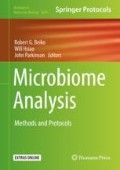Abstract
Microbial marker-gene sequence data can be used to generate comprehensive taxonomic profiles of the microorganisms present in a given community and for other community diversity analyses. The process of going from raw gene sequences to taxonomic profiles or diversity measures involves a series of data transformations performed by numerous computational tools. This includes tools for sequence quality checking, denoising, taxonomic classification, alignment, and phylogenetic tree building. In this chapter, we demonstrate how the Quantitative Insights Into Microbial Ecology version 2 (QIIME2) software suite can simplify 16S rRNA marker-gene analysis. We walk through an example data set extracted from the guts of bumblebees in order to show how QIIME2 can transform raw sequences into taxonomic bar plots, phylogenetic trees, principal co-ordinates analyses, and other visualizations of microbial diversity.
Access this chapter
Tax calculation will be finalised at checkout
Purchases are for personal use only
References
Anderson M (2005) PERMANOVA: a FORTRAN computer program for permutational multivariate analysis of variance, 24th edn. Department of Statistics, University of Auckland, Auckland
Callahan BJ, McMurdie PJ, Rosen MJ, Han AW, Johnson AJA, Holmes SP (2016) DADA2: high-resolution sample inference from Illumina amplicon data. Nat Methods 13(7):581
Caporaso JG, Kuczynski J, Stombaugh J, Bittinger K, Bushman FD, Costello EK, Fierer N, Pena AG, Goodrich JK, Gordon JI et al (2010) QIIME allows analysis of high-throughput community sequencing data. Nat Methods 7(5):335
Caporaso JG, Lauber CL, Walters WA, Berg-Lyons D, Lozupone CA, Turnbaugh PJ, Fierer N, Knight R (2011) Global patterns of 16S rRNA diversity at a depth of millions of sequences per sample. Proc Natl Acad Sci USA 108:4516–4522
Chapman M, Underwood A (1999) Ecological patterns in multivariate assemblages: information and interpretation of negative values in ANOSIM tests. Mar Ecol Prog Ser 180:257–265
Fadrosh DW, Ma B, Gajer P, Sengamalay N, Ott S, Brotman RM, Ravel J (2014) An improved dual-indexing approach for multiplexed 16S rRNA gene sequencing on the Illumina MiSeq platform. Microbiome 2(1):6
Faith DP (1992) Conservation evaluation and phylogenetic diversity. Biol Conserv 61(1):1–10
Katoh K, Standley DM (2013) MAFFT multiple sequence alignment software version 7: improvements in performance and usability. Mol Biol Evol 30(4):772–780
Lozupone C, Knight R (2005) UniFrac: a new phylogenetic method for comparing microbial communities. Appl Environ Microb 71(12):8228–8235
Lozupone CA, Hamady M, Kelley ST, Knight R (2007) Quantitative and qualitative β diversity measures lead to different insights into factors that structure microbial communities. Appl Environ Microb 73(5):1576–1585
McDonald D, Clemente JC, Kuczynski J, Rideout JR, Stombaugh J, Wendel D, Wilke A, Huse S, Hufnagle J, Meyer F et al (2012) The Biological Observation Matrix (BIOM) format or: how I learned to stop worrying and love the ome-ome. GigaScience 1(1):7
McDonald D, Price MN, Goodrich J, Nawrocki EP, DeSantis TZ, Probst A, Andersen GL, Knight R, Hugenholtz P (2012) An improved Greengenes taxonomy with explicit ranks for ecological and evolutionary analyses of bacteria and archaea. ISME J 6(3):610
Parmentier A, Meeus I, Nieuwerburgh F, Deforce D, Vandamme P, Smagghe G (2018) A different gut microbial community between larvae and adults of a wild bumblebee nest (Bombus pascuorum). Insect Sci 25(1):66–74
Pedregosa F, Varoquaux G, Gramfort A, Michel V, Thirion B, Grisel O, Blondel M, Prettenhofer P, Weiss R, Dubourg V et al (2011) Scikit-learn: machine learning in Python. J Mach Learn Res 12(Oct):2825–2830
Price MN, Dehal PS, Arkin AP (2010) FastTree 2–approximately maximum-likelihood trees for large alignments. PLoS One 5(3):e9490
Rideout JR, Chase JH, Bolyen E, Ackermann G, González A, Knight R, Caporaso JG (2016) Keemei: cloud-based validation of tabular bioinformatics file formats in Google Sheets. GigaScience 5(1):27
Author information
Authors and Affiliations
Corresponding author
Editor information
Editors and Affiliations
Rights and permissions
Copyright information
© 2018 Springer Science+Business Media, LLC, part of Springer Nature
About this protocol
Cite this protocol
Hall, M., Beiko, R.G. (2018). 16S rRNA Gene Analysis with QIIME2. In: Beiko, R., Hsiao, W., Parkinson, J. (eds) Microbiome Analysis. Methods in Molecular Biology, vol 1849. Humana Press, New York, NY. https://doi.org/10.1007/978-1-4939-8728-3_8
Download citation
DOI: https://doi.org/10.1007/978-1-4939-8728-3_8
Published:
Publisher Name: Humana Press, New York, NY
Print ISBN: 978-1-4939-8726-9
Online ISBN: 978-1-4939-8728-3
eBook Packages: Springer Protocols

